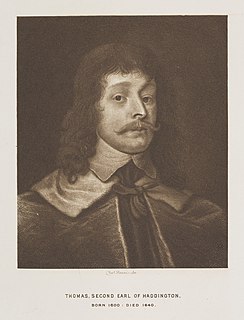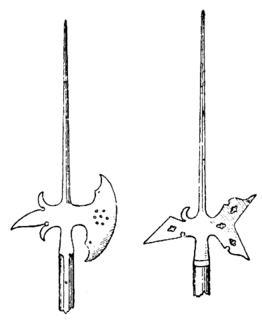
James V was King of Scotland from 9 September 1513 until his death, which followed the Scottish defeat at the Battle of Solway Moss. His only surviving legitimate child, Mary, Queen of Scots, succeeded him when she was just six days old.

Earl of Haddington is a title in the Peerage of Scotland. It was created in 1627 for the noted Scottish lawyer and judge Thomas Hamilton, 1st Earl of Melrose. He was Lord President of the Court of Session from 1616 to 1625. Hamilton had already been created Lord Binning in 1613 and Lord Binning and Byres, in the County of Haddington, and Earl of Melrose, in the County of Roxburgh, in 1619. These titles were also in the Peerage of Scotland. The title of the earldom derived from the fact that he was in possession of much of the lands of the former Melrose Abbey. However, Hamilton was unhappy with this title and wished to replace it with "Haddington". In 1627 he relinquished the earldom of Melrose and was instead created Earl of Haddington, with the precedence of 1619 and with limitation to his heirs male bearing the surname of Hamilton. This derived from the fact that he considered it a greater honour to take his title from a county rather than from an abbey. Hamilton was a member of the prominent Scottish family of that name and descended from John de Hamilton, younger son of Walter de Hamilton, who was granted the feudal barony of Cadzow and who is also the ancestor of the Dukes of Hamilton and Dukes of Abercorn.

Thomas Hamilton, 9th Earl of Haddington, KT, PC, FRS, FRSE, known as Lord Binning from 1794 to 1828, was a Scottish Conservative statesman.
Dr. John Hamilton, Scottish prelate and politician, was an illegitimate son of The 1st Earl of Arran.
The office of Lord Clerk Register is the oldest surviving Great Officer of State in Scotland, with origins in the 13th century.
John Hamilton-Leslie, 9th Earl of Rothes (1679–1722) was a Scottish nobleman who fought on the side of George I during the Jacobite rising of 1715.
The Bannatyne Club, named in honour of George Bannatyne and his famous anthology of Scots literature the Bannatyne Manuscript, was a text publication society founded by Sir Walter Scott to print rare works of Scottish interest, whether in history, poetry, or general literature. It printed 116 volumes in all. It was dissolved in 1861.
Sir James Melville (1535–1617) was a Scottish diplomat and memoir writer, and father of the poet Elizabeth Melville.
John Ramsay, 1st Earl of Holderness, known as Sir John Ramsay between 1600 and 1606, and as the Viscount of Haddington between 1606 and 1621, was an important Scottish aristocrat of the Jacobean era, best known in history as the first favourite of James I when he became king of England as well as Scotland in 1603.

Kirk o' Field in Edinburgh, Scotland, is best known as the site of the murder on 10 February 1567 of Lord Darnley, second husband of Mary, Queen of Scots, and father of King James VI. The site was occupied by the collegiate church of St Mary in the Fields, or the Kirk o' Field. It was approximately ten minutes' walk from Holyrood Palace, adjacent to the city wall, near to the Cowgate. The site is close to the location of the National Museum of Scotland.
James Tyrie was a Scottish Jesuit theologian.
Sir John Melville of Raith was laird of Raith in Fife, Scotland. He was active in the Scottish court in the second quarter of the 16th century, but was executed for his support of the Protestant cause.
Ninian Cockburn was a Scottish soldier and officer of the Garde Écossaise, a company which guarded the French king. He had an ambiguous role in political relations between Scotland, France and England during the war of the Rough Wooing and the Scottish Reformation.

Thomas Hamilton, 2nd Earl of Haddington was a Scottish nobleman.
Events in the year 1600 in the Spanish Netherlands and Prince-bishopric of Liège.
Marie Stewart, Countess of Mar, was a Scottish courtier.














